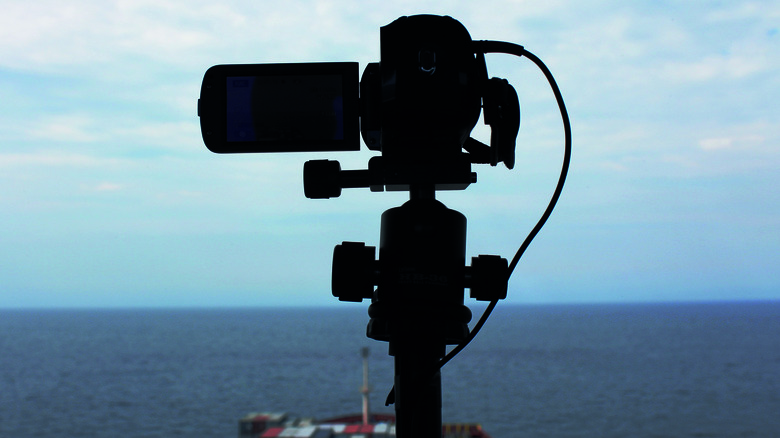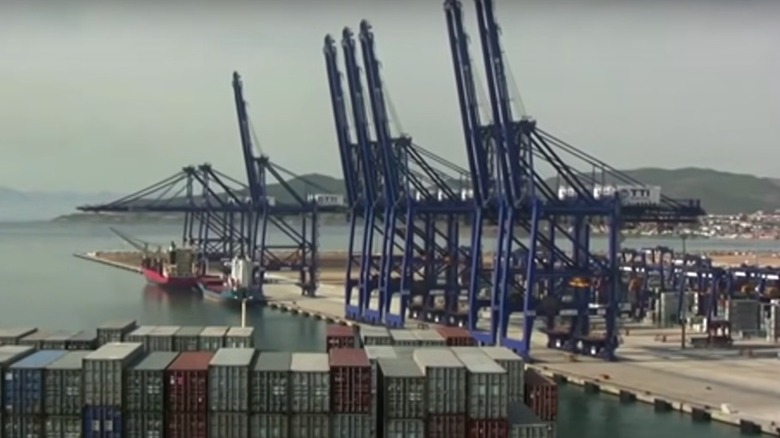The Untold Truth Of The Longest Movie Ever, Logistics
There has been a lot of discourse about Martin Scorsese's "Killers of the Flower Moon" — in particular, how long it is. It's so long, in fact, that there has been some talk about bringing back intermissions for theatrical showings of the film, as well as articles about when the best time is to sneak off for a bathroom break. Three hours and 26 minutes is certainly a long movie, no doubt about it. But it doesn't make it the longest movie of all time by even the longest of long shots.
In fact, you could watch "Killers of the Flower Moon" 240 times and still not have it equal the runtime of "Logistics" — the current record holder for the longest movie ever made. Part-art project and part-documentary, "Logistics" follows the 857-hour journey that a single pedometer took from where it was manufactured in China to the store where it was sold in Sweden and purchased by the filmmakers. Who would make a movie that long, and more importantly, has anyone actually watched it? We're tackling those questions and much more about this unusual film and its eye-watering length.
It's the brainchild of two Swedish artists
The longest movie of all time also has one of the smallest crews of all time. Only two people conceived of, filmed, and edited "Logistics" — both artists, both backstage crew members of the theater world, and both alumni of the Stockholm Academy of Dramatic Arts. Erika Magnusson and Daniel Andersson are the mad geniuses behind the movie, who came up with the idea in 2008 and had it finished by the end of 2012.
As the name implies, "Logistics" is about consumerism. According to the movie's official website, "The work is about Time and Consumption. It brings to the fore what is often forgotten in our digital, ostensibly fast-paced world: the slow, physical freight transportation that underpins our economic reality." It is said that they chose an "anonymous" item — a pedometer, appropriately enough — and decided to research the path that item took from where it was first made, all the way to the shop in Sweden where it was ultimately purchased. Once they determined that, they recreated the entire journey and filmed it, the bulk of which takes place on a large freight ship. The end result is "Logistics."
It's much longer than the Guinness World Record holder for longest movie
There's no doubt that some people reading this article clicked on it because they doubted its headline. And that's understandable, as Google searches for the longest movie ever made give conflicting and flat-out incorrect information on the subject. What really muddies up the waters is that the Guinness Book of World Records has its own certified "Longest Film Made" — an experimental 1987 movie called "The Cure for Insomnia." At 85 hours, the film is one long poetry reading by Chicago poet L.D. Groban. "The Cure for Insomnia" is certainly on any "longest movies ever made" list — but it has since been beaten by a handful of longer films, with Guinness not bothering to update the record for one reason or another despite the organization remaining very much active and continuing to certify new records all the time. Not to mention, nobody seems to be able to easily access "The Cure for Insomnia" anymore, especially given that Groban died in 2011.
In 2011, all previous contenders for the longest movie ever made were put to shame with the release of "Modern Times Forever." The 240-hour film — which looks at how a specific building in Finland has succumbed to millennia of decay — is significantly longer than any movie made up to that point. It's nearly three times as long as "The Cure for Insomnia," the movie that Guinness and numerous other sources continue to call the longest movie of all time. But "Modern Times Forever" only got to enjoy its record for a year, as "Logistics" was released in 2012 and established itself as the new No. 1 by a mile-wide margin.
It's a style of film known as durational cinema
On a surface level, it's easy enough to classify "Logistics." On its website, it's referred to as an art project — and in fact, it is sometimes called "Logistics Art Project" in articles that discuss it. Otherwise, being a nonfiction film documenting real events happening in front of its camera makes "Logistics" a documentary. But it turns out that there is a more specific genre that exists to describe "Logistics" and films like it. And yes, there are actually other films like it.
"Logistics" is part of a niche category of film known as durational cinema, also sometimes referred to as "slow cinema." Artist Andy Warhol is considered a pioneer of durational cinema, having created several films in the 1960s that are little more than real-time looks at someone sleeping, or looking at a building in real time for eight hours. And that's typically what defines durational cinema — a film that takes place in real time over an extended period, usually minimalist in nature with very little going on beyond incidental background activity. It's a genre that has gained in popularity among underground film enthusiasts in the last few decades. Scholar Lutz Koepnick wrote in his book "On Slowness: Toward and Aesthetic of the Contemporary" that slow cinema is a recent movement designed to "make us pause and experience a passing present in all its heterogeneity and difference."
It plays out entirely in reverse real time
Erika Magnusson and Daniel Andersson decided the only way to truly convey what they were trying to get across with "Logistics" was to film and present the entire journey in real time. Simply explaining that the pedometer's path from where it was created to where it was purchased for consumer use wasn't good enough — the route had to be shown in its entirety. Even if that route amounted to about 37 days.
However, the duo also said they were fascinated by the idea of looking backward on the journey, starting with the store they purchased the pedometer at and imagining its reverse trip all the way back to the original plant in China where it was first built. So that's when it was decided that "Logistics," too, should play out in reverse, with the 857 hours beginning at the store and then working backward through its journey on various forms of transportation. We travel by truck, then freight train, then truck again, ending at its birthplace at a factory in Bao'an in the city of Shenzhen, China, rather than starting there.
It's easy to view that decision as a gimmicky one, but it actually ends up making the message behind "Logistics" that much more powerful as it forces the viewer to start at the parts of a product's journey they are most familiar with and slowly introducing the lesser-known aspects of global trade as the movie goes on. We rarely think about where the things we purchase are actually made, so building up to that revelation is a masterstroke on the part of Magnusson and Andersson.
It was inspired by a story about an electric toothbrush
How does one even come up with such an idea as "Logistics"? It turns out that the impetus for what would become the longest movie ever made started with an electric toothbrush. Or, to be more precise, a story about an electric toothbrush. As Daniel Andersson explained in an interview with After Hrs, he and Erika Magnusson found an article in the German paper Der Spiegel in 2008 concerning an electric toothbrush. He said that they were intrigued by how the parts for that toothbrush came from 10 different countries and that this spurred them to start thinking about the complex machinations of the global economy and how manufactured goods travel around the planet.
The fact that such a seemingly simple item could have such a complicated logistical web with so many moving parts is hard to fathom. While it's likely that the pedometer that is the centerpiece of "Logistics" also has multiple parts that had to come from multiple places, Andersson and Magnusson ultimately decided to keep things (relatively) simple by having the journey showcased in the movie begin where the item was assembled. But the fact that even the finished pedometer needed to travel for over a month just to get to the store that was to carry it is something that most of us take for granted when we are out shopping and are picking up and buying things without giving much thought to how far they had to travel to get there.
It has screened at museums and film festivals
It's one thing to make an 857-hour movie. It's another to actually find a place to show an 857-hour movie. But yes, "Logistics" in its full, original, uncut glory has in fact screened in several places. It made its world debut in two places simultaneously — the Uppsala City Library and the Kulturhuset Stadsteatern, both in Sweden. It ran between December 2012 and January 2013, being shown at both of those locations in its entirety.
After that, "Logistics" has been screened at several film festivals and art shows, though typically in some sort of truncated fashion. In addition to its native Sweden, "Logistics" has also been made available for live viewing to audiences in Germany, China, the Netherlands, and the United States. The most recent known showing was in 2018 in Germany, and there aren't currently any confirmed plans for future screenings — the project's website hasn't been updated since 2021. However, that isn't to say that there hasn't been any other way to watch the movie or any current way to do so.
It was once available to rent online
The entire 857-hour version of "Logistics" streamed one time from the official site, but if you didn't happen to catch it, you're out of luck there. However, there was also a period where you could rent "Logistics" from the website Vimeo, for the rather economical price of $15 — which gives you a lot of bang for your buck in terms of the length of the content that $15 gave you. Upon purchase, you had three months to watch it, which is pretty generous, all things considered.
Unfortunately, "Logistics" has since been removed from Vimeo. According to a YouTube commenter who claims to have spoken to the filmmakers, the movie's removal came as a result of Vimeo updating the data cap on content that can be on the service. It's hard to blame a streaming company for not being willing to keep an 857-hour movie on their service, as that's a lot of bandwidth for something that isn't likely to bring in all that much cash. Still, it's a shame that — like so many other movies and shows you can't watch online these days — there isn't any way to watch the full version of "Logistics" on streaming. For a time, it was streamed on Twitch, but the last stream was in early 2023 with no currently announced plans for more viewings nor any saved clips to watch. Here's hoping we haven't seen the last of streamable options for this film, for pay or otherwise.
A 72-minute edit was made and is available on YouTube
Thankfully, "Logistics" isn't completely lost to time. For a while, there were a series of two-minute clips on the movie's website — one for each day of the journey — that were chosen by Erika Magnusson and Daniel Andersson and could be watched off the site. Likely because of the cost of keeping video hosted on a website, these clips have since been removed from the site.
But all is not lost, as those clips were compiled together into a single 72-minute edit of the movie, with added music, and uploaded to YouTube in 2019. As of this writing, that video remains on YouTube for anyone to watch. There are even replies on the video that claim to be from either Magnusson or Andersson (or both) which, if true, would indicate that they are aware of the video's existence and have no desire to have it removed. It's obviously a far cry from the full 857-hour version, but having even 72 minutes of footage from "Logistics" available to watch for free is better than nothing. And if we're being honest, a lot more people would be willing to watch a 72-minute movie — and with background music — than a nearly silent 857-hour movie. That fact is likely not lost on Magnusson and Andersson.
A film critic claims to have watched the entire 857-hour version
So has anyone actually watched all of "Logistics"? Plenty of snarky internet commentators have claimed to have done so — more on them later — but has anyone with any sort of credibility done it? A film critic and horror movie podcaster named Ashley Darrow says he did, and he wrote an entire piece for Canadian publication The Maple that documented his journey in watching all 857 hours of "Logistics." He also tweeted as he went, but those tweets have since been deleted.
"Logistics became more of a job than my job. Each morning, I would roll out of bed, grab my tablet and clock in for my shift watching Logistics," Darrow wrote, noting the daunting time commitment required to take the viewing of the movie on and to take it seriously. Throughout the piece, he not only comments on "Logistics" itself but also the endurance required to watch it, claiming that it gave him a migraine at one point. It's an extremely interesting read, as he reviews both the movie itself and also the experience of watching it, while also digging into a little bit of the history of slow cinema. It's obviously impossible to know for absolute certain if he did, in fact, watch the entire movie, but he's the only professional to even make the claim, which is noteworthy in and of itself.
Reviews are mixed but also difficult to verify
Other than Ashley Darrow's essay, there is nothing out there even approaching an actual, legitimate review of "Logistics." Which is fair, since its creators position it as more of an art piece than a movie — and art, especially art that takes over 800 hours to process, is rarely, if ever, "reviewed" in the traditional sense. You aren't going to find Rotten Tomatoes or Metacritic scores for "Logistics." The closest thing to any sort of aggregate scores for the movie come from sites like IMDb and Letterboxd, which allow users to review and score films.
For what it's worth, "Logistics" has an IMDb user score of 6.6 out of 10 and a Letterboxd score of 3.3 out of 5. But there is no way to verify that someone has actually watched a film in order to submit reviews to those sites, so take those scores with a grain of salt. Not surprisingly, many of the reviews on IMDb in particular are of the jokey variety, with headlines like "too short," "Action packed," and "Starts off slow." Some of it is entertaining to read, but it's still frustrating to attempt to get a sense for what people who have actually seen "Logistics" think of it — especially given that a limited number of people have had the opportunity to watch the full version — only to mostly find people using it as an excuse to show off their comedy-writing skills.
The creators claim it's actually a poetic experience
It's easy to assume that the actual watching of "Logistics" is an entirely sterile, utilitarian exercise. Given the intentions of the filmmakers in making the movie, it's also easy to assume that was their intention — to offer a no-frills presentation of the long and tedious journey that consumer items have to take from farm to table, as it were. Ashley Darrow identified in the film an examination of how our understanding of time and space is altered under capitalism.
Daniel Andersson offers up a different and somewhat surprising take on the "Logistics" viewing experience to After Hrs. He said that the film is a poetic experience and that the journey seems infinite. The images captured in the film — sunrise, sunset, the ocean waves, and the night sky — he said are beautiful images. And while much of his description doesn't seem like it would fit a 37-day-long movie that's mostly just a camera sitting on a boat full of freight boxes, it is indeed possible to find poetry and beauty almost anywhere. Even in a movie like "Logistics."











